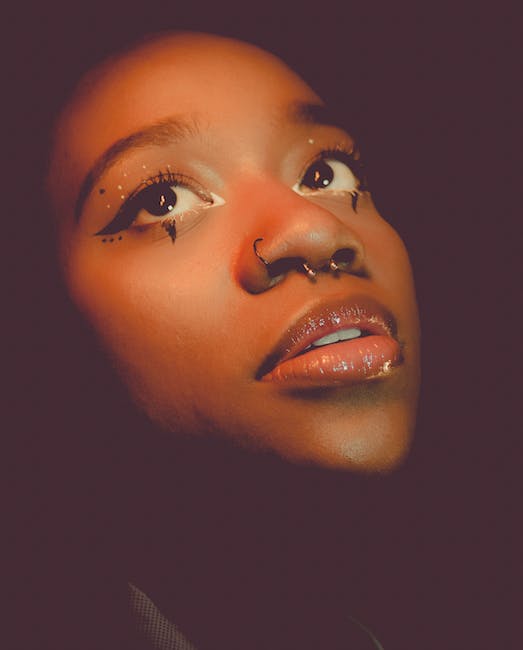Septum piercings have been gaining popularity across various cultures for decades, but their origin and significance run deeper than mere fashion trends. Throughout history, different societies have embraced septum piercings for various reasons, ranging from spiritual to cultural. By understanding the rich history behind septum piercings, we can appreciate their modern adaptations and their cross-cultural significance more fully.
Table of Contents
Interestingly, the tradition of septum piercings can be traced back to several ancient civilizations, such as the Aztecs, Mayans, and Incans. These cultures adorned their septum rings with gold and jade for religious significance. In India and other parts of the world, septum piercings have held aesthetic, cultural, and even sacred importance. With the passage of time, this cultural practice has evolved and been embraced by people from all walks of life.
Key Takeaways
- Septum piercings have historical and cultural roots in various ancient civilizations
- Piercings have evolved over time, becoming a popular fashion trend with symbolic significance transcending individual cultures
- Modern adaptations of septum piercings reflect a blend of cultural origins and contemporary influences.
Historical and Cultural Origins
Ancient Cultures
I’ve always been fascinated by the deep-rooted history behind septum piercings. It turns out that these piercings have been a part of various ancient cultures across the globe. Septum piercings were seen in the Middle East, Africa, and even among Aboriginal tribes in Australia.
India and Hinduism
My exploration into the cultural significance of septum piercings led me to India. I learned that nose piercings, particularly on the left nostril, hold a lot of importance in Hindu culture. They’re believed to help alleviate pain during childbirth and ease menstrual discomfort. In fact, Hindu women have been wearing nose rings long before the French songstress Polaire popularized it in Western culture in 1913.
Native American Tribes
Septum piercings were also prevalent among certain Native American tribes. It represented many things for these tribes, including social status, wealth, and spiritual connection. Northern American Indian tribes, like the Tlingit and Haida, used various materials like wood, bone, and others for their septum piercings.
Mayans and Incans
I discovered that septum piercings were an essential part of Mesoamerican cultures like the Aztecs, Mayans, and Incans. These people adorned their septum rings with gold and jade for religious significance. The rareness of these materials and the durability of jade make them symbolically significant in these cultures.
Solomon Islands and Asmat Tribe
My research also led me to the Solomon Islands and the Asmat Tribe of New Guinea. In these regions, warriors sported septum piercings as a symbol of strength and courage. They used unique materials like the bones of their enemies, which I found both fascinating and terrifying.
So, as I delved into the cross-cultural significance of septum piercings, I realized just how diverse and rich its history is. From ancient cultures to spiritual symbolism and warrior status, septum piercings truly have fascinating origins.

Cross-Cultural Significance
Rites of Passage
In numerous cultures, septum piercings have long served as important rites of passage. For instance, I found that the indigenous tribes of North America would often utilize tibia bones as septum jewelry to mark social statuses within their communities. Similarly, ear piercing is a common practice to mark significant moments in an individual’s life, such as their transition into adulthood. On the whole, body modifications like these hold incredible cultural significance across diverse societies, allowing me to appreciate just how deeply rooted these practices are in various traditions.
Symbols of Adulthood and Marriage
Perhaps one of the most fascinating aspects of septum piercings lies in their role as symbols of adulthood and marriage. For instance, some Indian communities hold the practice of wearing nose rings in high esteem, as these adornments often represent a woman’s marital status or readiness for adulthood. In contrast, septum piercings in Western culture started as a sign of rebellion, but have since evolved into an alternative expression of style, often divorced from their initial connotations.
Spiritual and Community Ties
Septum piercings can carry a spiritual meaning, reflecting one’s ties to a higher power or community. While researching, I discovered that some Australian aboriginal and New Guinean tribes would perform this ritual to connect individuals to their cultural heritage and reinforce spiritual bonds. Similarly, for some tribes in Colombia and Ecuador, septum piercings are a means to identify spiritual leaders and strengthen the sense of community within the group.
So, as I delved into the cross-cultural significance of septum piercings, it became evident that these adornments hold unique and different meanings, traversing diverse regions and communities. Personally, I find it incredibly fascinating to discover how united we are through our shared practices, despite the unique manifestations of each culture.
Modern Adaptations and Trends
Punk Rock Movement
When I think of septum piercings, I can’t help but associate them with the punk rock movement. In the 1970s and 1980s, septum piercings became a symbol of rebellion and counterculture. Along with tattoos and other body modifications, they were embraced by people who sought to challenge societal norms and express their individuality. For the punk rockers, it wasn’t just about the aesthetics of the piercings, but also the act of defiance that came with it.
Contemporary Celebrity Influence
Fast forward to today, septum piercings have made quite the comeback, thanks to the influence of celebrities such as Rihanna. Their modern, edgy, and sometimes delicate designs have helped to shift the perception of septum piercings from symbols of rebellion to appealing fashion statements. Besides Rihanna, other famous figures like Shawnee leaders and even some hippies have been known to sport septum piercings, further popularizing the accessory.
Trends in Jewelry Design
Just like other types of piercings, septum piercings have various styles of nose rings and septum clickers to choose from. The design and materials used in septum jewelry have evolved over time. Initial jewelry options for septum piercings were made of surgical steel, silver, or nickel-free gold, but now we see a wider variety of materials, like platinum.
The current trends in septum jewelry design range from traditional hoop-style nose rings to more delicate, dainty, and intricate pieces. I personally like the subtle pieces that add just a touch of personality to my look.
To sum it up, septum piercings have gone through a rollercoaster of cultural significance. From being a symbol of rebellion in the punk rock movement to a trendy accessory thanks to celebrity influence, septum piercings have definitely evolved over time. The ever-growing variety in jewelry design keeps this fashion statement appealing and fresh.
Health Considerations and Materials
Common Materials
When it comes to septum piercings, the materials used for the jewelry are crucial for my overall health and comfort. I’ve found that some popular choices include surgical steel, silver, nickel-free gold, and platinum. Surgical steel is a top choice for many people because it’s highly resistant to corrosion, making it perfect for long-term use in body modifications like piercings.
As for me, I’m fond of wearing silver as it offers a more affordable and stylish alternative. However, not all silver is created equal, so I make sure to choose high-quality, hypoallergenic varieties. For others who have skin sensitivities or allergies to common metals, nickel-free gold and platinum are options to consider.

Potential Health Risks
With any form of body modification, there are some potential health risks to be aware of. Hygiene is absolutely crucial when it comes to septum piercings. I’ve learned that poor cleaning practices can lead to infections, a risk that can be minimized with proper care and maintenance.
When I first got my septum pierced, I made sure to keep the area clean using a saline solution, as recommended by my piercer. Additionally, I tried to avoid touching my piercing with unclean hands and didn’t change the jewelry before it was fully healed. By doing so, I managed to minimize any potential infection risks.
Another health consideration I had to keep in mind was the possibility of an allergic reaction to the materials used in my piercing. As I mentioned earlier, choosing hypoallergenic metals like surgical steel, nickel-free gold, or platinum was essential to avoid any issues.
The bottom line is, while septum piercings may be a beautiful and meaningful form of self-expression across various cultures, it’s crucial for me to consider the materials used and potential health risks. By making informed choices and following proper hygiene practices, I can enjoy my piercing without compromising my health and well-being.
